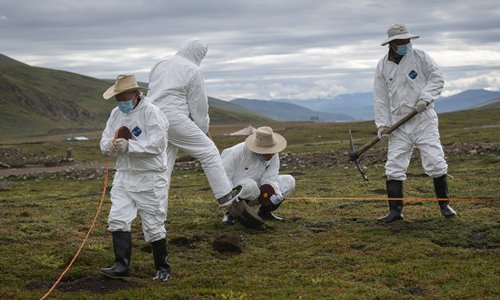
Mice control team works in Ganzi, Southwest China's Sichuan Province to examine the population of the rodent and test whether they carries plague bacteria in September 2019. Photo: VCG
Diseases throughout history were contained after countries implemented prevention measures by developing medicine, disinfectants, and face masks.
Recently, a migrant worker from Lincang, a city in Southwest China's Yunnan Province, died from the hantavirus, which may have been caused by contact with rats, sparking wide concerns among netizens.
Chinese medical experts confirmed that although the hantavirus belongs to the level four of biological hazard and fatal disease, it has rarely been found to transmit from one person to another.
"For transmitting channel, the disease caused by hantavirus has lower risks than pestilences," Bai Honglian, chief doctor of infections department of a in Foshan, South China's Guangdong Province, told the Global Times.
A virus is led by a kind of bacteria, and the most dangerous ones are transmitted through the respiratory system and can severely damage the lungs, causing respiratory failure, Bai noted.
The similarity between a pestilence and hantavirus is their intermediate host. The bacteria and virus can attach to the bodies of rats.
The earliest virus epidemic happened in Europe in 1347. At that time, people knew little about the disease from a medical perspective, and there was no concept of "infectious disease".
Almost 25 million people lost their lives to the pandemic, nearly a third of Europe's population.
In 1894, an epidemic swept through Hong Kong and South China's Guangdong Province, but medicine had developed enough for medical experts to create a remedy to control the outbreak.
Two virologists studied the microbes that cause the virus. They found bacteria in the body fluids of victims, injected them into animals, and observed the animals quickly died. This was how yersinia pestis was discovered.
Experts cultivated the diphtheria antitoxic serum from horses and injected the serum within two days after the onset of the disease in sick children, the cure rate was nearly 100 percent, according to a recent report.
After learning the disease is transmitted through contact with rats, ports and ships implemented rodent control procedures and the use of pesticides in virus-hit regions.
However, in 1910, an epidemic struck eastern China. The virus was originated in Russia and killed over 60,000 people.
Wu Delian, the first Chinese to receive a doctorate in medicine from the University of Cambridge, made contributions to pandemic prevention in Harbin, Northeast China's Heilongjiang Province.
Wu suggested measures to the government, including railway control and road traffic to contain the epidemic.
Wu proposed that it could be transmitted by droplets between breaths without the use of an animal vector, and called it the pneumonic plague.
To prevent respiratory infections, Wu designed a double-layer gauze capsule mask, which uses two layers of gauze and an absorbent cotton pad inside to isolate patients. The face mask is still in use today.
In memory of Wu, a memorial hall was built in his honor in Harbin.
Hantavirus disease is preventable and controllable and there are vaccines to prevent it, experts said.

